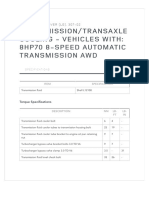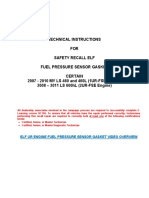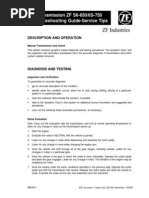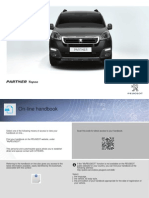Inspeccion de Fuga
Inspeccion de Fuga
Uploaded by
Alejandro BasilicoCopyright:
Available Formats
Inspeccion de Fuga
Inspeccion de Fuga
Uploaded by
Alejandro BasilicoOriginal Title
Copyright
Available Formats
Share this document
Did you find this document useful?
Is this content inappropriate?
Copyright:
Available Formats
Inspeccion de Fuga
Inspeccion de Fuga
Uploaded by
Alejandro BasilicoCopyright:
Available Formats
307-01B-i Automatic Transaxle/Transmission — 6R80 307-01B-i
SECTION 307-01B Automatic Transaxle/Transmission — 6R80
CONTENTS PAGE
DIAGNOSIS AND TESTING
Leakage Inspection .......................................................................................................................................................... 307-01B-2
Leak Check Test ........................................................................................................................................................ 307-01B-2
2009 Explorer, Mountaineer, Explorer Sport Trac, 12/2008
307-01B-2 Automatic Transaxle/Transmission — 6R80 307-01B-2
DIAGNOSIS AND TESTING
Leakage Inspection
Special Tool(s)
Leak Tester, Torque Converter
307-691
Material
Item Specification
Dye-Lite® ATF/Power Steering Fluid Leak Detection Dye —
164-R3701 (Rotunda)
Leak Check Test
NOTE:
When diagnosing transmission leaks, the source of the leak must be positively identified prior to repair. If the vehicle is driven extensively between adding
the fluorescent additive and performing the leak test, the leaking oil can spread and make identifying the location of the leak difficult.
1. Clean off any transmission fluid from the top and bottom of the torque converter housing, the front of the case and rear face of the engine and oil pan.
Clean the torque converter area by washing with a nonflammable solvent and blow dry with compressed air.
2. Add Dye-Lite® ATF Power Steering Fluid Leak Detection Dye to the transmission fluid. Use one 30 ml (1 fl. oz) of dye solution for every 3.8 L (4
qt) of transmission fluid.
3. Start and run the engine until the transmission reaches its normal operating temperature. Raise the vehicle on a hoist and run the engine occasionally
shifting to the DRIVE and REVERSE ranges to increase pressure within the transmission. Using a black light, observe the back of the cylinder block
and top of the torque converter housing for evidence of fluid leakage. Run the engine until transmission fluid leakage is evident and the probable
source of leakage can be determined.
4. If the source of the leak is obvious, repair as required. Leaks from the torque converter housing can originate from several locations. The paths which
the fluid takes to reach the bottom of the torque converter housing are shown in the illustration. The 5 steps following correspond with the numbers in
the illustration.
1 Transmission fluid leaking by the converter hub seal lip will tend to move along the drive hub and onto the back of the torque converter. Except
in the case of a total seal failure, transmission fluid leakage by the lip of the seal will be deposited on the inside of the torque converter housing
only, near the outside diameter of the housing.
2 Transmission fluid leakage by the outside diameter of the converter impeller hub seal and the case will follow the same path that leaks by the ID
of the converter hub seal follow.
3 Transmission fluid leakage from the converter cover weld or the converter-to-flexplate stud weld will appear at outside diameter of torque
converter on the back face of the flexplate and in the converter housing only near the flexplate. If a converter-to-flexplate lug, lug weld or
converter cover weld leak is suspected, remove the converter and pressure check.
4 Transmission fluid leakage from the bolts inside the converter housing will flow down the back of the torque converter housing. Leakage may be
from loose or missing bolts.
2009 Explorer, Mountaineer, Explorer Sport Trac, 12/2008
307-01B-3 Automatic Transaxle/Transmission — 6R80 307-01B-3
DIAGNOSIS AND TESTING (Continued)
5 Engine oil leaks from the rear main oil.
5. Remove the torque converter.
6. Using a black light, observe the torque converter housing. Inspect for evidence of dye from the pump bolts, pump seal, and torque converter hub seal.
Repair as required.
7. If the source of the leak is not evident, continue with this procedure to leak test the torque converter.
8. Install the torque converter in the arbor press. Support the torque converter on the mounting pads.
9. Install the Leak Tester, Torque Converter 307-691 into the torque converter hub.
10. Secure the press. Only apply enough force from the press to seal the Leak Tester, Torque Converter 307-691 into the torque converter hub.
11. Connect a compressed air supply to the Leak Tester, Torque Converter 307-691.
2009 Explorer, Mountaineer, Explorer Sport Trac, 12/2008
307-01B-4 Automatic Transaxle/Transmission — 6R80 307-01B-4
DIAGNOSIS AND TESTING (Continued)
12. With air pressure applied to valve, inspect for leaks at the converter hub weld and seams. A soap bubble solution can be applied around those areas to
aid in the diagnosis. If any leaks are present, install a new torque converter.
13. With air pressure applied to valve, inspect for leaks at the stud or mounting pad and balance weight welds. A soap bubble solution can be applied
around those areas to aid in the diagnosis. If any leaks are present, install a new torque converter.
14. After leaks are repaired, clean the remaining transmission fluid dye from serviced areas.
2009 Explorer, Mountaineer, Explorer Sport Trac, 12/2008
You might also like
- Allison Transmission Service Manual PDFDocument326 pagesAllison Transmission Service Manual PDFMitul Patel97% (29)
- Bendix Air Brake System Schematic PDFDocument1 pageBendix Air Brake System Schematic PDFraidhemed67% (3)
- Automatic Gearbox 0B6 Four-Wheel DriveDocument185 pagesAutomatic Gearbox 0B6 Four-Wheel DriveergdegNo ratings yet
- Mercedes Axor Fuel System Repair ManualDocument20 pagesMercedes Axor Fuel System Repair ManualStephenson75% (4)
- SZCADocument140 pagesSZCAMichal WlodarczykNo ratings yet
- Land Rover 4HP22 Hydraulic Transmission - Service, Diagnostic & TestingDocument51 pagesLand Rover 4HP22 Hydraulic Transmission - Service, Diagnostic & TestingRiahi Rezeg86% (7)
- GM Automatic Overdrive Transmission Builder's and Swapper's GuideFrom EverandGM Automatic Overdrive Transmission Builder's and Swapper's GuideRating: 4.5 out of 5 stars4.5/5 (8)
- Manual Yamaha YFM350FADocument4 pagesManual Yamaha YFM350FAJesus J. ZuñigaNo ratings yet
- CF150T-5I (E-Charm EFI) Maintenance ManualDocument243 pagesCF150T-5I (E-Charm EFI) Maintenance ManualjoeNo ratings yet
- A 131LDocument70 pagesA 131LGustavo Gamez100% (2)
- Altec Federal Government Product CatalogDocument146 pagesAltec Federal Government Product CatalogNanciu Marian100% (3)
- Outback 20011 2.5, 2,5t 3.0Document5,950 pagesOutback 20011 2.5, 2,5t 3.0Josue SilvaNo ratings yet
- ZF Transmission ZF s6 650 - 6s 750 Troubleshooting GuideDocument35 pagesZF Transmission ZF s6 650 - 6s 750 Troubleshooting GuideTekmikeNo ratings yet
- Test Sequence For Caterpillar 7000 Series Fuel Nozzles (1254)Document15 pagesTest Sequence For Caterpillar 7000 Series Fuel Nozzles (1254)galo11061989100% (3)
- CAT 3412 Air Inlet and Exhaust SystemDocument8 pagesCAT 3412 Air Inlet and Exhaust SystemCEVegaO100% (2)
- 39 - Eaton Clark 280V Transmission Service Manual PDFDocument54 pages39 - Eaton Clark 280V Transmission Service Manual PDFSomadbsi100% (3)
- Testing and Adjusting: Troubleshooting The Transmission Hydraulic SystemDocument24 pagesTesting and Adjusting: Troubleshooting The Transmission Hydraulic SystemLeandro Sal91% (11)
- 2005 Chevrolet ChevyDocument8 pages2005 Chevrolet ChevyDavid100% (1)
- SM - HD785-5 LCDocument976 pagesSM - HD785-5 LCnurdinzai100% (1)
- Agri Loadall: Gross Power: 81kW/109hp - 108kW/145hp Lift Capacity: 3,100kg - 4,100kg Lift Height: 6.2m - 9.5mDocument28 pagesAgri Loadall: Gross Power: 81kW/109hp - 108kW/145hp Lift Capacity: 3,100kg - 4,100kg Lift Height: 6.2m - 9.5manzorNo ratings yet
- A750 TransmissionDocument30 pagesA750 Transmissionjohnatan chui100% (3)
- Condiciones de VerificacionDocument4 pagesCondiciones de VerificacionAlejandro BasilicoNo ratings yet
- Cooling - With 8HP70 8-Speed at AWDDocument29 pagesCooling - With 8HP70 8-Speed at AWDAndreyNo ratings yet
- Supermatic Transmission 8l90 19417579 19417580Document30 pagesSupermatic Transmission 8l90 19417579 19417580Eduardo MontesNo ratings yet
- Rcrit 14V647 9581Document43 pagesRcrit 14V647 9581Eko PurwantoNo ratings yet
- Supermatic 8l90 Transmission Kit Installation InstructionsDocument36 pagesSupermatic 8l90 Transmission Kit Installation Instructionszerroug.mehdi26No ratings yet
- 2000H Service Wheel Loader 993KDocument4 pages2000H Service Wheel Loader 993KmhmdtrainingNo ratings yet
- Testing and Adjusting HIDRAULICDocument34 pagesTesting and Adjusting HIDRAULICJorge A. Artica100% (1)
- 3306B MrhernadezDocument108 pages3306B MrhernadezAnderson SalazarNo ratings yet
- Diagnostico Convertidor de TorqueDocument3 pagesDiagnostico Convertidor de TorqueAlejandro BasilicoNo ratings yet
- A/T - No Reverse/3rd or 5th Gear/MIL ON/DTC P0776Document6 pagesA/T - No Reverse/3rd or 5th Gear/MIL ON/DTC P0776Carlos CuellarNo ratings yet
- TSB 2100306Document13 pagesTSB 2100306ossoskiNo ratings yet
- Testing And Adjusting d346Document76 pagesTesting And Adjusting d346Tito EdyNo ratings yet
- PDF 18aug24 0707 SplittedDocument26 pagesPDF 18aug24 0707 Splittedfrank mutaleNo ratings yet
- Presiones 988bDocument24 pagesPresiones 988bMarielisa Zertuche FloresNo ratings yet
- Supermatic Transmission (19260380, 19260961, 19299055 or 19329645) SpecificationsDocument11 pagesSupermatic Transmission (19260380, 19260961, 19299055 or 19329645) SpecificationsDennys TiapaNo ratings yet
- 924F Pruebas y AjustesDocument26 pages924F Pruebas y AjustesSan Gabriel Representaciones100% (1)
- Auto TransmissionDocument61 pagesAuto Transmissionlamping_ap100% (1)
- ExhaustDocument39 pagesExhaustFernando Cidre100% (1)
- MeritorWABCO-Hydraulic ABS Leak Check-TP0555Document4 pagesMeritorWABCO-Hydraulic ABS Leak Check-TP0555ford62bNo ratings yet
- Fuel Injection Nozzle - Test: Shutdown SIS Previous ScreenDocument6 pagesFuel Injection Nozzle - Test: Shutdown SIS Previous ScreenbejoythomasNo ratings yet
- Transfer Case PDFDocument19 pagesTransfer Case PDFCatalin BuleandraNo ratings yet
- 140h Air Sys and BrakesDocument15 pages140h Air Sys and BrakesDaniel Tekle100% (1)
- Transfer Case 233 Chevrolet S10Document8 pagesTransfer Case 233 Chevrolet S10Maxi SardiNo ratings yet
- ZF Transmission ZF s6 650 - 6s 750 Troubleshooting Guide PDFDocument34 pagesZF Transmission ZF s6 650 - 6s 750 Troubleshooting Guide PDFBrenda Arnold100% (1)
- lifterDocument11 pageslifterEdward SpitzerNo ratings yet
- 938FDocument21 pages938Fمحمد يونسNo ratings yet
- Pruebas Direccion HidraulicaDocument4 pagesPruebas Direccion HidraulicaRafael Antonio Ostos SanchezNo ratings yet
- Steering System Power Rack and Pinion PDFDocument6 pagesSteering System Power Rack and Pinion PDFOskars Štāls0% (1)
- V40232 Clark C270 Torque ConverterDocument44 pagesV40232 Clark C270 Torque ConverterRemHenry100% (6)
- At 01M Overhaul 95-96Document61 pagesAt 01M Overhaul 95-96Вадим УрупаNo ratings yet
- 2000H Service 16M GraderDocument3 pages2000H Service 16M GraderMohamedNo ratings yet
- Ajuste Precio 416cDocument23 pagesAjuste Precio 416cpedro melendez100% (1)
- Power Steering System: Section 6ADocument13 pagesPower Steering System: Section 6AJarry PotterNo ratings yet
- Checklist RigDocument104 pagesChecklist RigKiryaki Francis100% (2)
- Powertrain Troubleshooting (Test and Adjust)Document11 pagesPowertrain Troubleshooting (Test and Adjust)Jean Jacques ouanda100% (1)
- Service Bulletin: Spring Brake Modulating Relay ValveDocument6 pagesService Bulletin: Spring Brake Modulating Relay Valveluis eduardoNo ratings yet
- Basic Testing Pajero 1991Document12 pagesBasic Testing Pajero 1991nadaNo ratings yet
- Clutch Chevro S10 1997Document12 pagesClutch Chevro S10 1997roberto galvan100% (1)
- Diagnosis and TestingDocument12 pagesDiagnosis and TestingRepuesto GeneralNo ratings yet
- 938F 7SN Wheel Loader and It38f Integrated Toolcarrier Power TrainDocument23 pages938F 7SN Wheel Loader and It38f Integrated Toolcarrier Power Trainale aleNo ratings yet
- Electronic Unit Injector - Test: Shutdown SIS Previous ScreenDocument2 pagesElectronic Unit Injector - Test: Shutdown SIS Previous ScreenbejoythomasNo ratings yet
- 3412C Fuel System Pruebas y AjustesDocument13 pages3412C Fuel System Pruebas y AjustesJuan Carlos Inga Vasquez100% (1)
- C32 MOTOR CAT Electronic Unit Injector - TestDocument2 pagesC32 MOTOR CAT Electronic Unit Injector - TestFreddy Villegas100% (1)
- Transmision Ford-Freestyle - 2006 - EN - Manual - de - Taller - Sistema - Transmision - De8e9a84c3Document26 pagesTransmision Ford-Freestyle - 2006 - EN - Manual - de - Taller - Sistema - Transmision - De8e9a84c3Carlos Ortega MartinezNo ratings yet
- Ford-Freestyle 2006 en Manual de Taller Sistema Transmision De8e9a84c3Document26 pagesFord-Freestyle 2006 en Manual de Taller Sistema Transmision De8e9a84c3Jaime ManzanoNo ratings yet
- Test de Presiones de Transmision 938g2Document12 pagesTest de Presiones de Transmision 938g2cristian chuquicondor torres100% (2)
- SB03 3Document14 pagesSB03 3Clemente Rafael Marval Escalona100% (1)
- Stories from the Road 3: An Automotive Case Studies SeriesFrom EverandStories from the Road 3: An Automotive Case Studies SeriesNo ratings yet
- Torqueflite A-727 Transmission Handbook HP1399: How to Rebuild or Modify Chrysler's A-727 Torqueflite for All ApplicationsFrom EverandTorqueflite A-727 Transmission Handbook HP1399: How to Rebuild or Modify Chrysler's A-727 Torqueflite for All ApplicationsNo ratings yet
- Construction EquipmentDocument11 pagesConstruction EquipmentBơm Junjin Bê TôngNo ratings yet
- H&R SRS Brosura Uleiuri Automotive, Industriale Si UnsoriDocument8 pagesH&R SRS Brosura Uleiuri Automotive, Industriale Si UnsoriDaniel DaiaNo ratings yet
- Current Measurement in Solenoids For Automotive Control SystemsDocument3 pagesCurrent Measurement in Solenoids For Automotive Control SystemsJorge GuerreroNo ratings yet
- ManishDocument25 pagesManishRudra Sai SandeepNo ratings yet
- Gearbox HistoryDocument9 pagesGearbox HistoryScribdTranslationsNo ratings yet
- HL740 9SDocument4 pagesHL740 9SMarco Olivetto0% (1)
- Internship ReportDocument42 pagesInternship ReportPrathamesh GothankarNo ratings yet
- BMW SIB General Service Bulletin List 2Document24 pagesBMW SIB General Service Bulletin List 2aka122378No ratings yet
- Safari 14 PDFDocument211 pagesSafari 14 PDFKatherine Harney100% (2)
- E38 Immobiliser System EWS3Document4 pagesE38 Immobiliser System EWS3naamikekwekuaduNo ratings yet
- Peugeot Partner Tepee 2015 Owners ManualDocument298 pagesPeugeot Partner Tepee 2015 Owners ManualMusaHamzicNo ratings yet
- History: Horseless Carriage Boston MassachusettsDocument1 pageHistory: Horseless Carriage Boston MassachusettsGary M Trajano100% (1)
- TE32+MANUAL (FZ Transm) (009-040)Document32 pagesTE32+MANUAL (FZ Transm) (009-040)Marco GuachunNo ratings yet
- Motor Grader Terex DimensionDocument16 pagesMotor Grader Terex DimensionMaulana Fajriansyah100% (2)
- Continuous Variable: TransmissionDocument17 pagesContinuous Variable: TransmissionSanthosh GoudNo ratings yet
- AUTOMOTIVE SET A Mastery TestDocument5 pagesAUTOMOTIVE SET A Mastery TestRon louise PereyraNo ratings yet
- TF 81SC VBL Interactive PDFDocument1 pageTF 81SC VBL Interactive PDFJUAN ENRIQUE TORRIJOS FLORESNo ratings yet
- Eg Carburetor: Petrol-Gas Switchover Device For Carburetor or Injection Type Vehicles User Manual Ver 1.3 - 01.04.2015Document12 pagesEg Carburetor: Petrol-Gas Switchover Device For Carburetor or Injection Type Vehicles User Manual Ver 1.3 - 01.04.2015fatehNo ratings yet
- Remanufactured Wabco ECUs & Actuators - H L SmithDocument2 pagesRemanufactured Wabco ECUs & Actuators - H L SmithYoùssef ModesteNo ratings yet

























































































